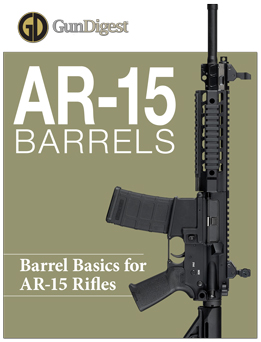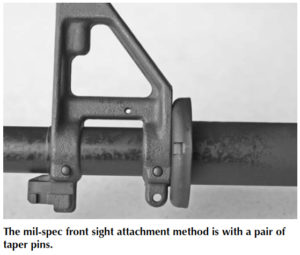Get Your Free Download! Know AR-15 Barrels Inside and Out…
There are few other firearms that offer as much modularity and interchangeability as the AR-15. One of the key parts of this rifle is the barrel, and there is no shortage of aftermarket AR parts to supply the shooting public’s insatiable demand. You can add shorter barrels to your AR-15, or longer. Heavy or light contour. The possibilities are endless. This download covers the parts of the AR-15 barrel, AR 15 Bull Barrels, barrel materials and extensions, internal AR-15 barrel parts, rifling twist, the muzzle, gas ports, how to clean the barrel and using a bore guide…plus:
• AR-15 Barrel Length
• AR-15 Barrel Weight
• Custom AR 15 Barrels
• Headspace
• AR-15 Barrel Tools
• Tips on the Best AR 15 Barrels
Before you upgrade your AR-15, download this essential primer!
To receive your free download, join our mailing list and never miss news, tips, promotions or discounts.

Here’s a Sneak Peek Inside Your Free Guide to AR-15 Barrels:

And as a chrome-moly steel, you can ream the chamber to adjust headspace if your bolt happens to produce less than minimum headspace when you first check it. Any barrel is simply a steel tube. At the rear is the chamber, in the middle the bore, and the end is the crown.
A barrel receives a cartridge, holds it for firing, launches a bullet along a known and predictable path, and does so for as long as the steel can take the work. All manufactured products must be made within specifications.
Any product is made to within a maximum and minimum size. It simply isn’t feasible or economically wise to make each and every part perfect, conforming exactly to the specifications drawn. So, each part will have a maximum and minimum size, with all parts falling within that spread. For example, we refer to the .223/5.56 as being a “.22” or using .224-inch bullets.
Actually, the bullets can (depending on who is making them, and for what application) be any size from .2235 inches to .2245 inches and the interior of the barrel, the bore, has another set of specifications. A match barrel may be held to a smaller spread, but there is still a spread. And a barrel may vary from one end to the other.
Again, a Match barrel varies less, but if you were to measure a perfect barrel, and find the bore averages .22410 inches, it may vary between .22408 and .22412 inches along its length. A non-match barrel may vary from .22392 inches to .22415 inches or more.
And most measuring instruments won’t even register the fifth digit, so a barrel that measures between
.2239 and .2241 could be quite good. So, when we talk of a barrel being Match we simply mean the dimensions are held between a smaller spread of max and min.

AR-15 Barrel Material
You’ll see barrels touted as “stainless,” “chromed,” “match” and “G.I.” And other terms as well. What they are telling you is what it is made of, how it is treated, and in some cases (as in the “GI” part) the general specifications of it.
A barrel is made of steel. Steel is iron with a small amount of carbon in it for hardness. If you want to flip through the specs, the American National Standards Institute can tell you more than you need to know about steel. There are all sorts of alloying metals that can be added. “Alloy” simply tells you that something besides iron and carbon are in there. It does not necessarily mean that it is a hard, tough or desirable steel.
Some things harden it, some things make it easier to machine. Others add uniformity to the crystalline structure, making it easier to forge, heat-treat, machine or otherwise fabricate into barrels. Some alloying materials add corrosion resistance, others abrasion resistance. Carbon steel has no alloying components that reduce oxidation (rust).
Stainless steel does have some, primarily chromium or nickel, or both. (A chrome steel is not the same as a chromed barrel) However, you cannot add enough of them to make a steel truly “stainless.” By the time you have done so it is so soft it isn’t useful as a steel, except for kitchen tableware.
A chromed barrel has either the chamber, or the chamber and bore, plated with chromium. But not bumper chrome, instead a hard, tough layer of chromium that resists corrosion, abrasion and heat. Very early M-16 barrels had nothing, then briefly they had only chamber chromed to resist corrosion and aid extraction.
Once the process was refined enough, the entire bore was chromed. A chromed bore is much tougher in the long run.
However, the plating is not as uniform in thickness, coverage and smoothness to make it attractive to competition shooters. At least not the long-range ones. While three-gun shooters will often gladly use a chromed bore, serious long range shooters will only use stainless Match barrels.
As for “GI,” it means whatever the maker wants it to. Now, if they were to say Mil-spec, and quote a particular military specification, then that is different. The government has exacting standards, know as Military Specifications, or Mil-spec. If someone says their (barrel, extractor, shoelaces) is “mil-spec” then you can look up the spec cited and see just what they’re claiming.
Claim Your Free Copy of Barrel Basics for AR-15 Rifles
Join the Gun Digest newsletter and start mastering AR-15 Barrels!
